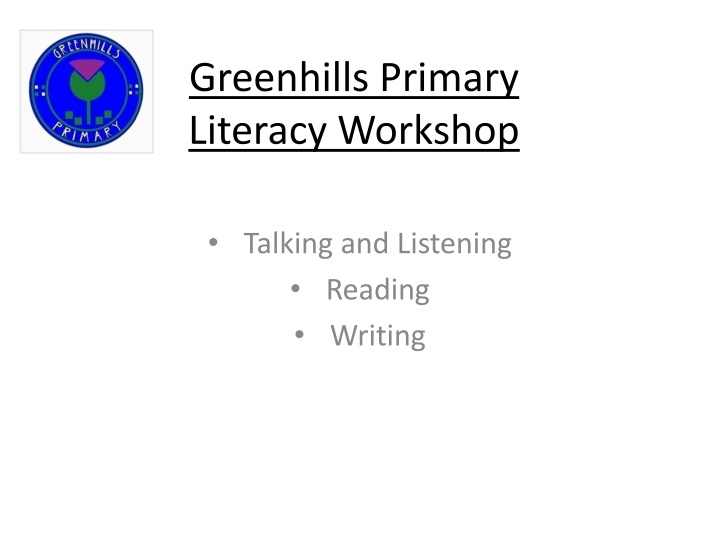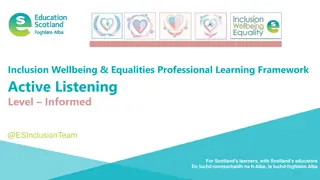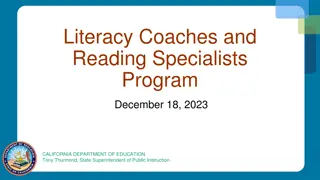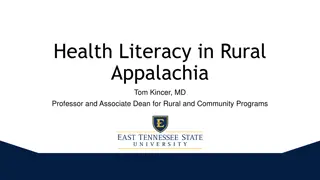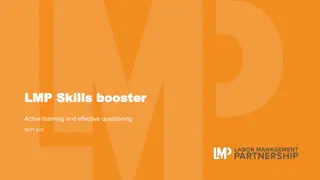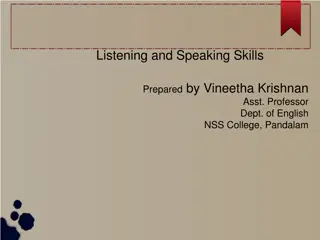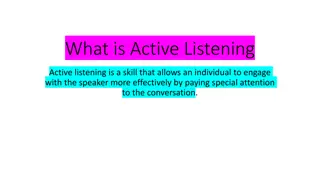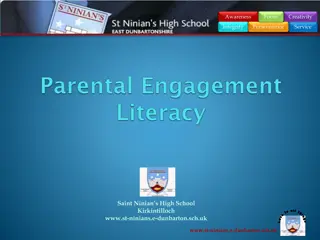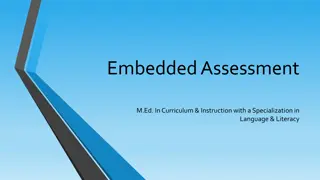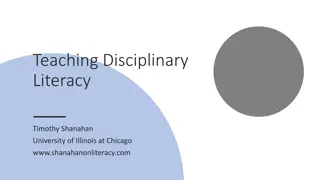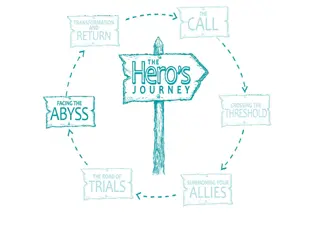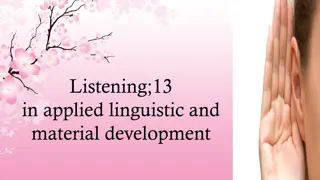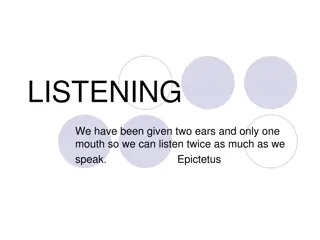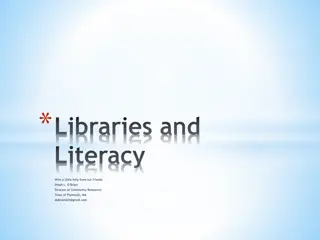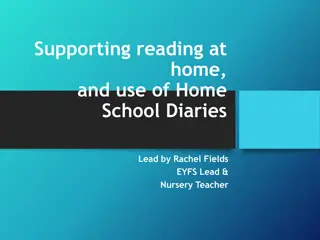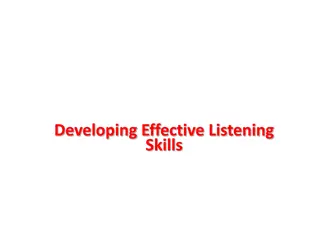Greenhills Primary Literacy Workshop - Talking, Listening, Reading, Writing
This workshop encourages children to share ideas, explore, and engage in discussions to enhance their communication skills. Through talking and listening, reading, and writing activities, students develop critical thinking and comprehension skills. The workshop covers various aspects of literacy, including phonics, comprehension, guided reading, and writing strategies, fostering a holistic approach to literacy education.
Uploaded on Mar 06, 2025 | 3 Views
Download Presentation

Please find below an Image/Link to download the presentation.
The content on the website is provided AS IS for your information and personal use only. It may not be sold, licensed, or shared on other websites without obtaining consent from the author.If you encounter any issues during the download, it is possible that the publisher has removed the file from their server.
You are allowed to download the files provided on this website for personal or commercial use, subject to the condition that they are used lawfully. All files are the property of their respective owners.
The content on the website is provided AS IS for your information and personal use only. It may not be sold, licensed, or shared on other websites without obtaining consent from the author.
E N D
Presentation Transcript
Greenhills Primary Literacy Workshop Talking and Listening Reading Writing
Talking and Listening Children are encouraged to share and explore ideas in pairs, trios, groups or whole class discussions in order to: solve problems reflect on their learning respond to a text or event i.e. talk about pictures, words, headings, use of language, genre and talk about their feelings, thoughts and ideas. Also retell stories (sequence), predict, share opinions about a text and justify these
Reading Children are taught and encouraged to: read with and to a partner (and help each other) talk to and listen to one another about what they have read discuss the main points of the story Who? What? Where? What happened next? write about what they have read read what they have written and in collaboration with others, edit and fine tune their writing
Writing Children are taught and encouraged to: write daily for different reasons share ideas about their writing work collaboratively to check and improve their writing All three organisers of Literacy are taught within an integrated approach i.e. there are clear links
Reading Features of teaching Reading: Phonics Comprehension Guided reading Paired reading Word attack strategies
Reading Phonics Introduce initial sounds first hear sound at beginning and end of words, recognise sound orally and written, generate words with sound at beginning, write sounds 2 letter phonemes e.g. sh, ee, oy Use of magnetic letters- Say Make/Break Blend Read Write Focus on collegiate working together
Reading Comprehension Before (prediction), during (understanding) and after reading (recall) Questioning e.g. can the title/pictures tell me what the story might be about? Who is in the story? Where does the story take place? What happens at the beginning/ middle/end of the story? Moving on to inferential questions and children generating their own questions Summarising the story Making links to own experiences and the wider world
Reading Guided Reading Teacher introduces book, encourages use of prior knowledge to make connections, prediction skills, draws attention to new words and punctuation Children read book independently Discussion of story characters, events, setting, significant words, find words that start with the same sound, words containing previously taught phonemes Follow up activities individual/pairs/groups, includes letter, word and sentence work. Focus on building independent learners
Reading Paired Reading Excellent approach for parents! Child selects a book Sit comfortably side by side Look at title and front page read title together and ask child what story might be about Start reading book together go at child s speed Agree a hand signal when your child wants to read alone. Praise your child for wanting to read alone If your child gets stuck at a word give him/her a short time to try and work it out then tell the child the word if needed In paired reading you do not ask the child to break up a word or sound it out When the story is finished talk about what has happened in the story
Reading Word Attack Strategies (skills to help decode words) Look at the first letter Look for a rhyme e.g. at as in cat Break the words into syllables Sound the first few letters Read the sentence again Look at the last letters Look at the pictures Look at the shape of the word
Writing Key Principles. All children need to: Have fun in writing Develop a positive attitude towards writing See themselves as writers Have daily opportunities to write Have regular opportunities to hear good quality texts
Writing Features of teaching Writing: Linking Talking and Listening, Reading and Writing Big writing lessons- relevant and meaningful to children s experiences Daily writing opportunities opportunities for children to extend their own thinking and improve independence Writing across the curriculum for different purposes Spelling including common words
Writing Tools for writing: Children need to be able to articulate what they want to write (talking and listening) Children need to be able to write each letter Children need to understand the need for a space between each word Children need to be able to use the phonemes to have a go at writing Children need to be able to read back what they have written Children are introduced to capital letters, full stops and question marks then the use of and as a connective
Spelling Aspects of teaching spelling: listen to the sounds in words identify the number of symbols in words look at word shapes and patterns remembering words using look and say method (flashcards) thinking about and discussing tricky words (words that cannot be sounded out e.g. want) talking about words
Common Words Common words are introduced to the children right away in Primary 1. Children are taught to read and write the common words. Regular practice is given in school. Between week 1 and week 4 the children will be introduced to: a at the I is it an in and
Assessment Regular assessment is used to ensure children are working at a level that is appropriate: POLAAR (Primary One Literacy Assessment and Action Resource) RRWA (Regular Reading Word Assessment) PM Benchmarking Daily work in school is assessed to ensure children are supported/challenged
How you can help your child Talk to your child, listen and respond Read daily to your child (not always paired reading, enjoy books together) Support your child with homework little and often is the key Please sign reading record and use this to communicate with the teacher about reading Ensure your child has their reading book in school every day Speak to your child s teacher regarding any concerns
Additional information (attached) 1. Correct pronunciation of initial sounds sheet 2. Correct formation of letters sheet 3. Reading homework hints sheet 4. How to help your child with phonics sheet 5. How to help your child with reading
